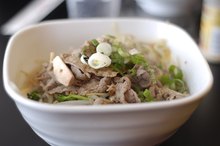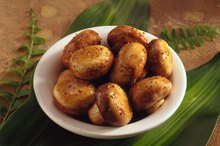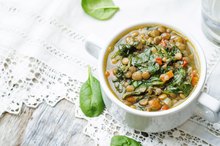What does fact checked mean?
At Healthfully, we strive to deliver objective content that is accurate and up-to-date. Our team periodically reviews articles in order to ensure content quality. The sources cited below consist of evidence from peer-reviewed journals, prominent medical organizations, academic associations, and government data.
- "Nutrition, Metabolism and Cardiovascular Diseases"; Effect of Proteins from Different Sources on Body Composition; J.A. Gilbert, et al.; May 2011
- "Nutrition, Metabolism and Cardiovascular Diseases"; Effect of Proteins from Different Sources on Body Composition; J.A. Gilbert, et al.; May 2011
- Centers for Disease Control and Prevention: How to Use Fruits and Vegetables to Help Manage Your Weight
The information contained on this site is for informational purposes only, and should not be used as a substitute for the advice of a professional health care provider. Please check with the appropriate physician regarding health questions and concerns. Although we strive to deliver accurate and up-to-date information, no guarantee to that effect is made.
Pea Soup Diet
Pea soup offers you a comforting way to fill yourself up with minimal calories; however, a pea soup diet falls within the same fad diet category such as the Cabbage Soup Diet. Losing weight by including pea soup to meet your dietary requirement can be a sound weight loss strategy, provided you also limit your caloric intake to create a calorie deficit.
Food Group
The peas used to make pea soup count as both a meat and a vegetable, as peas contain a substantial amount of protein per serving. Traditional pea soup combines water, dried split peas, ham, onions, carrots, celery and seasonings to create a thick, rich soup, according to the "Betty Crocker Cookbook." The carrots, onions and celery contribute to your 2 cups of vegetable requirement, and the seasonings add no calories 2. When losing weight, omit the ham as 2.5 oz. of diced ham has 85 calories, which makes it a higher calorie addition to the soup.
- The peas used to make pea soup count as both a meat and a vegetable, as peas contain a substantial amount of protein per serving.
- of diced ham has 85 calories, which makes it a higher calorie addition to the soup.
Calories and Nutrients
Carbohydrates in Wasabi Peas
Learn More
Pea soup without ham contains about 190 calories per 1 1/2 cups, according to Michigan State University. The soup gives you 13 g of protein, or about 30 percent of a woman's needs and 23 percent of a man's requirements. The trace of fat means you have room in your diet for other healthy fats from olive oil or nuts, and the 13 g of fiber keeps you full long after you eat the soup. You get about 70 percent of your vitamin A requirement in 1 1/2 cups, 10 percent of your iron needs and small amounts of vitamin C and calcium.
- Pea soup without ham contains about 190 calories per 1 1/2 cups, according to Michigan State University.
- You get about 70 percent of your vitamin A requirement in 1 1/2 cups, 10 percent of your iron needs and small amounts of vitamin C and calcium.
Expert Insight
Protein helps you lose weight because it satisfies you, helps you burn calories and aids with reducing fat in your body, according to a study published in the May 2011 issue of "Nutrition Metabolism, and Cardiovascular Diseases." Both plant proteins, such as those in pea soup, and animal proteins help reduce body fat 3. Additionally, the Centers for Disease Control and Prevention recommends replacing meat or refined grains with a legume such as peas to help you eat fewer calories and still feel full 4. The physical act of eating soup takes longer than consuming a serving of meat or a slice of bread, which helps you eat more slowly, and allows your stomach to send a "full" signal to your brain.
Inclusion Strategies
The Nutrition of Pho Soup
Learn More
Eating pea soup several times a day may cause you to experience boredom because of the lack of variety, and the high amount of dietary fiber can cause intestinal discomfort. Eat the soup for lunch or dinner, and choose other low-calorie foods from the fruits, whole grains and fat-free dairy groups for your other meals. For a sodium-free pea soup, make your own soup from dried peas rather than relying on canned pea soup, which often has excessive sodium.
Related Articles
References
- USDA Nutrient Data Laboratory: Peas
- "Betty Crocker Cookbook"; 2005
- "Nutrition, Metabolism and Cardiovascular Diseases"; Effect of Proteins from Different Sources on Body Composition; J.A. Gilbert, et al.; May 2011
- Centers for Disease Control and Prevention: How to Use Fruits and Vegetables to Help Manage Your Weight
- Kuroda M, Ohta M, Okufuji T, et al. Frequency of soup intake is inversely associated with body mass index, waist circumference, and waist-to-hip ratio, but not with other metabolic risk factors in Japanese men. J Am Diet Assoc. 2011;111(1):137-42. doi:10.1016/j.jada.2010.10.004
- Zhu Y, Hollis JH. Soup consumption is associated with a reduced risk of overweight and obesity but not metabolic syndrome in US adults: NHANES 2003-2006. PLoS One. 2013;8(9):e75630. doi:10.1371/journal.pone.0075630
- Wright N, Wilson L, Smith M, Duncan B, Mchugh P. The BROAD study: A randomised controlled trial using a whole food plant-based diet in the community for obesity, ischaemic heart disease or diabetes. Nutr Diabetes. 2017;7(3):e256. doi:10.1038/nutd.2017.3
- Pan A, Hu F. Effects of carbohydrates on satiety: Differences between liquid and solid food. Curr Opin Clin Nutr Metab Care. 2011;14(4):385-390. doi:10.1097/mco.0b013e328346df36
Writer Bio
Diane Lynn began writing in 1998 as a guest columnist for the "Tallahassee Democrat." After losing 158 pounds, she wrote her own weight-loss curriculum and now teaches classes on diet and fitness. Lynn also writes for The Oz Blog and her own blog, Fit to the Finish. She has a Bachelor of Science in finance from Florida State University.









